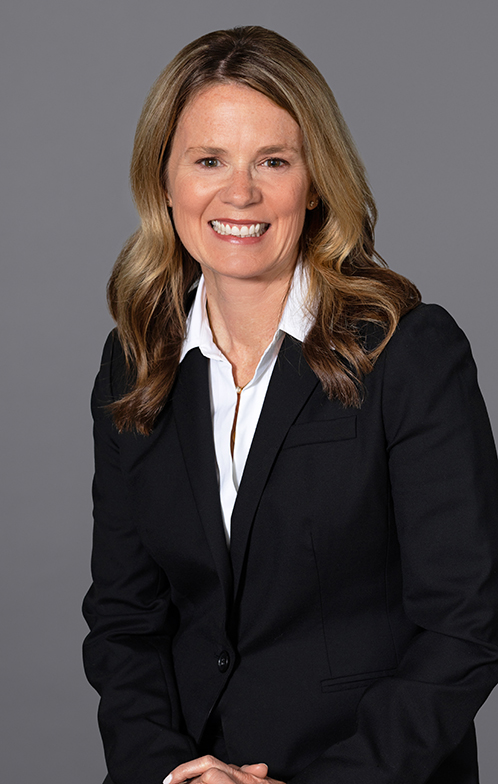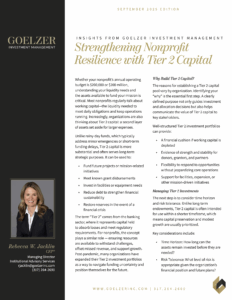
Rebecca W. Jacklin
CFP®
Managing Director,
Institutional Advisory Services

Managing Director,
Institutional Advisory Services
 Whether your nonprofit’s annual operating budget is $200,000 or $200 million, understanding your liquidity needs and the assets available to fund your mission is critical. Most nonprofits regularly talk about working capital—the liquidity needed to meet daily obligations and keep operations running. Increasingly, organizations are also thinking about Tier 2 capital: a second layer of assets set aside for larger expenses.
Whether your nonprofit’s annual operating budget is $200,000 or $200 million, understanding your liquidity needs and the assets available to fund your mission is critical. Most nonprofits regularly talk about working capital—the liquidity needed to meet daily obligations and keep operations running. Increasingly, organizations are also thinking about Tier 2 capital: a second layer of assets set aside for larger expenses.
Unlike rainy-day funds, which typically address minor emergencies or short-term funding delays, Tier 2 capital is more substantial and often serves long-term strategic purposes. It can be used to:
The term “Tier 2” comes from the banking sector, where it represents capital held to absorb losses and meet regulatory requirements. For nonprofits, the concept plays a similar role — ensuring resources are available to withstand challenges, offset missed revenue, and support growth. Post-pandemic, many organizations have expanded their Tier 2 investment portfolios as a way to navigate funding uncertainty and position themselves for the future.
The reasons for establishing a Tier 2 capital pool vary by organization. Identifying your “why” is the essential first step. A clearly defined purpose not only guides investment and allocation decisions but also helps communicate the value of Tier 2 capital to key stakeholders.
Well-structured Tier 2 investment portfolios can provide:
The next step is to consider time horizon and risk tolerance. Unlike long-term endowments, Tier 2 capital is often intended for use within a shorter timeframe, which means capital preservation and modest growth are usually prioritized.
Key considerations include:
Many organizations choose diversified portfolios of lower-risk assets, such as laddered bond portfolios or U.S. Treasuries, while others may blend multiple investment vehicles depending on objectives and timing.
We recently connected with two Goelzer clients and asked them to share their thoughts on how they think about Tier 2 capital.
Alice Susemichel, CEO of the Brown County Community Foundation (BCCF) offered these thoughts on the value of their Tier 2 investment pool and how it helps the community foundation managing passthrough funds and meet the current needs of the community.
“In a small, rural county, the needs can be both urgent and diverse—including education, affordable housing, health and wellness and environmental stewardship. Opportunities to make a meaningful impact often arise unexpectedly, requiring quick access to capital. Some of these opportunities are driven by grantors while others are decisions made by fund advisors of non-permanent/passthrough funds.
To meet these moments, the Brown County Community Foundation created a Tier 2 investment pool—a separate fund from the main long-term investment portfolio. Unlike operating reserves or rainy-day funds, these assets are strategically set aside for unique purposes, allowing the foundation to be nimble and responsive. By managing these funds differently, the foundation can pursue collaborative projects, invest in innovative solutions, and address community challenges as they emerge—all while maintaining the stability of the primary endowment.
Strategically, our Tier 2 investment pool helps our foundation balance mission and stewardship, offering flexibility to act quickly without disrupting the long-term growth of our core investment pool. This approach reflects a forward-thinking commitment to managing capital efficiently while staying ready to seize opportunities that can transform and realize our vision of a thriving community.”
Jennifer Gallagher, CFO of the United Way of Central Indiana, offered these thoughts:
“The Tier 2 investment structure is a smart, forward-looking approach that aligns projected cash flow for expenditures with multi-year grant funding, ensuring resources are available when they’re most needed. It maximizes the earning potential of funds while providing money managers with clear timelines and dollar thresholds, reducing ambiguity and strengthening accountability. With its efficient annual review and reset, this structure simplifies oversight for investment committees and boards, making disbursement decisions and timing far more transparent and strategic.”
As suggested by both of these leaders, a strong understanding of your organization’s liquidity needs helps as you think about Tier 2 capital. Further, strategically thinking about a complete well-managed capital structure including daily liquid assets, Tier 2 capital, and long-term asset pools will help your organization to effectively plan for the future and be prepared for the unexpected.
As these examples show, Tier 2 capital strengthens a nonprofit’s ability to plan strategically and respond effectively. By thoughtfully managing all layers of capital—daily liquidity, Tier 2 reserves, and long-term investments—organizations can build resilience, maintain stability, and seize opportunities that advance their mission.
DISCLAIMER: This report includes candid statements and observations regarding risk management strategies; however, there is no guarantee that these statements or opinions will prove to be correct. Actual results may differ materially from those we anticipate. The views and strategies described in the piece may not be suitable to all readers and are subject to change without notice. The information is not intended to provide and should not be relied on for accounting, legal, and tax advice or investment recommendations. Investing in stocks involves risk, including loss of principal. Past performance is not a guarantee of future results.
ABOUT GOELZER: With over 50 years of experience and more than $4 billion in assets under advisement, Goelzer Investment Management is an investment advisory firm that leverages our proprietary investment and financial planning strategies to help successful families and institutions Dream, Invest, and Live.